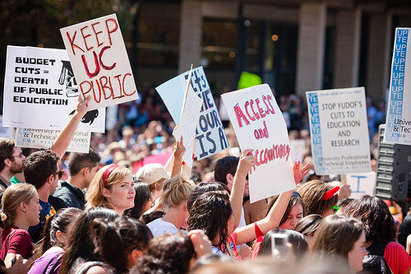California Public Higher Education Faces Uncertain Future
Sophia Li | Staff Reporter
The University of California’s recent budget cuts have not gone unnoticed by students.
UC Berkeley sophomore Dwight Hu said he has seen fewer available lectures and discussion sessions, larger class sizes and a smaller faculty compared to last year.
“Berkeley has offered me everything I expected and more,” said Hu, who believes that as a student of the smaller College of Chemistry, he has been isolated from many of the issues that impact students in other fields. “But I guess for a lot of students it is more difficult to get individual help.”
In its 2013-2014 operating budget, the UC system admitted to not prioritizing quality “as it should be” given changes in state funding. While state funds made up 24 percent of the UC’s total budget in 1990-1991, that number has decreased to only about 10 percent for 2012-2013.
And even though the UC was able to stabilize its funding for the 2013-2014 school year thanks to Proposition 30, which raised state income and sales taxes to fund public education, former Berkeley chancellor Robert Birgeneau told HuffPost last week that state funding is not going to return to how it was 20 years ago.
“The reality is that the current budget is not stable in the long run and so the challenges are not over,” Birgeneau said.
As state support has fluctuated over the past two decades, the UC has raised tuition and fees to help mitigate budget cuts, said Director of Operating Budget Clifton Brown. Although tuition increases are unpopular and often met with protests, as they were in 2009 across numerous UC campuses, Birgeneau said they will rise again, “ideally, at a moderate rate.”
UC campuses began to cut expenditures and increase efficiencies in response to significant budget gaps in the 2008-2009 academic year. Since then, over 180 programs have been either eliminated or consolidated. Over 9,500 positions have been eliminated or unfilled and more than 4,200 staff have been laid off.
Although the UC has downsized on programs and staff, enrollment has continued to increase. The UC estimates it enrolls more than 25,000 California residents who are not funded by the state. But while many campuses saw their enrollment grow, the UC faculty as a whole shrank in 2012-2013. These disproportionate changes made it difficult for schools to maintain a small student-faculty ratio, which the UC said it intends to reduce by 2020.
Issues of decreased staff numbers and increased workloads have plagued other state-funded schools including community colleges such as Pasadena City College (PCC).
“As people retire or find employment elsewhere, we’ve been unable to replace those bodies so the work has had to be managed by the remaining staff,” said PCC accountant Anthony Brown.
According to Brown, PCC’s primary method to combat reductions in funding has been to cut the number of classes. Last year, PCC offered 578 fewer classes than the year before.
PCC has also saved money by eliminating its winter session, although according to student trustee Simon Fraser, the decision was not due to budget cuts. Fraser, who voted against dropping the winter session, said the lack of one hindered some students’ attempts to transfer to four-year universities. Many students liked and benefited from the winter sessions, according to Fraser, and they were not happy when the sessions were eliminated.
Unless state funding increases, most California public colleges and universities will be forced to make further cuts and increase fees, both of which will likely hurt Hu and many of his fellow UC Berkeley classmates.
“I feel like tuition is starting to get out of control at many public schools, particularly the University of California,” Hu said. “It’s sad because it kind of defeats the purpose of public schools. Because to me, they are supposed to provide education for a wide variety of people regardless of their income, at least to a certain extent. Whereas the reality of things is that now a lot of people struggle mightily to afford tuition for public universities.”
[Source]: NeonTommy.com



